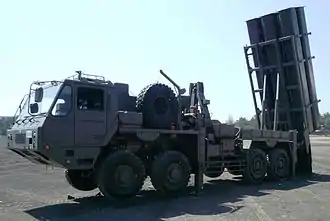Type 12 Surface-to-Ship Missile
The Type 12 Surface-to-Ship Missile (12式地対艦誘導弾) is a truck-mounted anti-ship missile developed by Japan's Mitsubishi Heavy Industries in 2012. It is an upgrade of the Type 88 Surface-to-Ship Missile. The Type 12 features INS with mid-course GPS guidance and better precision due to enhanced Terrain Contour Matching and target discrimination capabilities. The weapon is networked, where initial and mid-course targeting can be provided by other platforms, and also boasts shorter reload times, reduced lifecycle costs, and a range of 124 mi (108 nmi; 200 km).[1][2]
| Type 12 Surface-to-Ship Missile | |
|---|---|
 | |
| Type | Anti-ship cruise missile |
| Place of origin | Japan |
| Service history | |
| In service | 2015 |
| Production history | |
| Manufacturer | Mitsubishi Heavy Industries |
| Specifications | |
| Mass | 700 kg (1,500 lb) |
| Length | 5 m (16.4 ft) |
| Diameter | 350 mm (13.8 in) |
| Warhead | HE |
Operational range | 200 km (108 nmi; 124 mi) 400 km (216 nmi; 249 mi)(Ship/air launched and improved version) |
Guidance system | Inertial guidance, GPS and terminal Ka band AESA radar homing |
Launch platform | Truck (Oshkosh, Mitsubishi) |
The missile shares the same Ka-band Active Electronic Scanned Array(AESA) radar seeker with Japanese BVRAAM missile, AAM-4B.[3]
The ship-launched derivative of Type 12, designated as Type 17 (SSM-2) missile has been put into service and it is to start deploying from Maya-class destroyer. The range has doubled to 400 kilometers and is also planning to re-apply for the improved version of the surface-to-ship system and the air-launched variant for the P-1 patrol aircraft.[4][5]
The MoD approved the development of an improved version of the Type 12 SSM on December 18, 2020 by the Cabinet. According to Japanese newspapers, the range will be extended from 200 km to 900 km, with a future target of 1,500 km. It will have a stealthy shape to reduce RCS, as well as high mobility to prevent interception from the enemy. It can attack not only naval vessels but also ground targets. The MoD intends to launch the improved Type 12 SSM not only from the ground, but also from naval vessels and aircraft.[6]
See also
References
- China Reacts to Japanese Anti-Ship Missile Positioning - News.USNI.org, 18 June 2014
- Japan Plans To Deploy Missiles To Strategic Island Near Taiwan - Foxtrotaplha.Jalopnik.com, 19 May 2015
- Defense Agency Technical Research & Development Institute 50 Years of History, II 技術研究開発 8.第3研究所(II Technology Research and Development 8. Third laboratory) TRDI50_10.pdf file page.278-279 - Japan National Diet Library, 2002
- Overview of FY2017 Budget Request(English), Page.28 - Ministry of Defense Japan
- Ground-to-ship missile doubling the range improvement, Senkaku / Miyako, against China(Japanese) - Sankei.com, 29.April 2019
- Inaba, Yoshihiro (21 January 2021). "Japan To Greatly Extend Range Of Type 12 Anti-Ship Missiles, Modify It For F-15J". Navalnews. Retrieved 21 January 2021.
